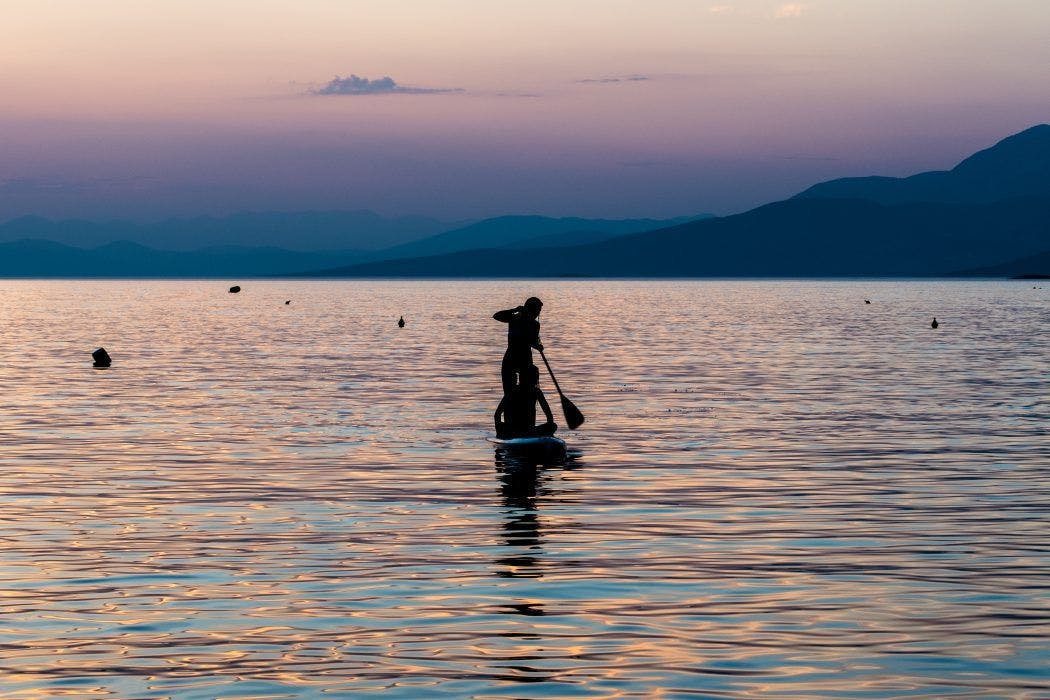You see pictures all over in online publications, magazines of people just blissfully standing on this board and paddling away into the sunrise. Must be easy enough?
The truth is unless you have good balance from the get-go, paddling a stand up paddleboard as a beginner can be an activity that features a steep learning curve. The benefits that you can experience from paddle boarding can be endless. Below I will show you how to do it.
Gear: What You need
The following is some gear that you will need to have before you get started
- Life Vest ( Either a belt or Life Vest PFD)
- Sun Protection (Hat Sunglasses, sunscreen)
- Bathing Suit (if the water is warm)
- Wetsuit (if the water is cooler)
- A paddle that fits you
- Board Leash
- Whistle
- Paddle Board
Should I Rent or Own a Stand Up Paddle Board?
This is ultimately up to you if you are trying a paddleboard for the first time I would rent one of an hour or two to see how you like the activity! There are a lot of different locations that will have them available to you. Starting out I would paddle in calmer water like protected bays and smaller lakes to ensure that you have a stable surface to balance on.
If you decide to jump right in and own a Paddle Board front he get-go you have more flexibility as to where to go. Inflatable paddleboards are easier to transport while hardboard will give you more stability on the water.
Starting Out
Before you board your SUP be sure that you launch from a safe, calm area. A place with lots of sand is usually a pretty good launching point in case you fall off. Try to avoid any areas with bigger rocks or barnacles around as those can do some damage!
Launching
- To start off with, wade into knee-deep water with your paddleboard ahead of you.
- Place your paddle across your board and place whichever knee is closest to the board on it. As soon as it feels stable enough, climb onto the stand-up paddleboard.
- At this point, you will be on all fours on the board. From here try to get on your knees and get adapted to paddling the board around for a bit from your knees. By all means, you can just stay on your knees or sit down and paddle.
- In the kneeling position have the paddle across the board, hold it with your fingers and place your toes on the board.
- Place one knee in front of the chest with your foot firmly places on the board
- Start to rise and put your other foot parallel to your other foot and in the “squat” position slowly rise.
- When you are in the standing position it is highly recommended that you place the blade of your paddle in the water and start a slow paddling motion. The board will be easier to balance when it has momentum on the water, similar to a bicycle.
- Once you have a bit of momentum in the water try and find that sweet spot of balance on your board by slowly sifting your feet around. If it feels at least semi-balanced then stay in your position and keep paddling gently.
Paddle Technique
You will notice that a SUP paddle is different from a kayak paddle in that the blade looks tilted to one side. You want to make sure that when you are paddling, the blade is pointed away from you not towards you. This ensures that you have better power per stroke and makes it easier to move around in the water. When gripping your paddle make sure that one hand is at the very top of the handle gripping it firmly, and the other hand is on the upper middle part of the shaft.
What if you Fall?
If you are just starting out, there is a good chance that you may fall into the water. It’s all part of the learning experience! If you are at the point of no return and are extremely unbalanced, try to fall feet first! This will lessen the probability of you hitting your head on the board or any other object that may be nearby. You should also be wearing a PFD and an ankle leash so that you can be safe in the water all the while having your board close by.
When you fall in the water, the first priority is to get your paddle. After all, you don’t want to be down Schitts Creek without a paddle! I highly recommend getting a paddle that actually floats in the water to lessen the percentage of you losing it. Once you grab your paddle, swim back to your SUP and prepare to board.
To get back onto your paddleboard simply go to its side, place your paddle across the board so that it doesn’t fall off, and haul yourself onto the board using the carry handle of the paddleboard. Think of it the same way as a seal would haul himself onto an ice flow.
Wrapping it Up
After your first couple of tries, you should get an idea if stand up paddle boarding is for you or not. As with anything in life, the more you practice, the more comfortable you will be on the board. After a few years of me paddleboarding and making all the mistakes you can possibly make. These methods will help ease your learning curve. Remember paddleboarding is a fun activity to be enjoyed. I personally find it extremely meditative to be out on the calm water, listening to the breeze and gazing into the horizon. You will find the gentle rocking will relax and you all of the problems you faced previously will all but float away.


Comments are closed.